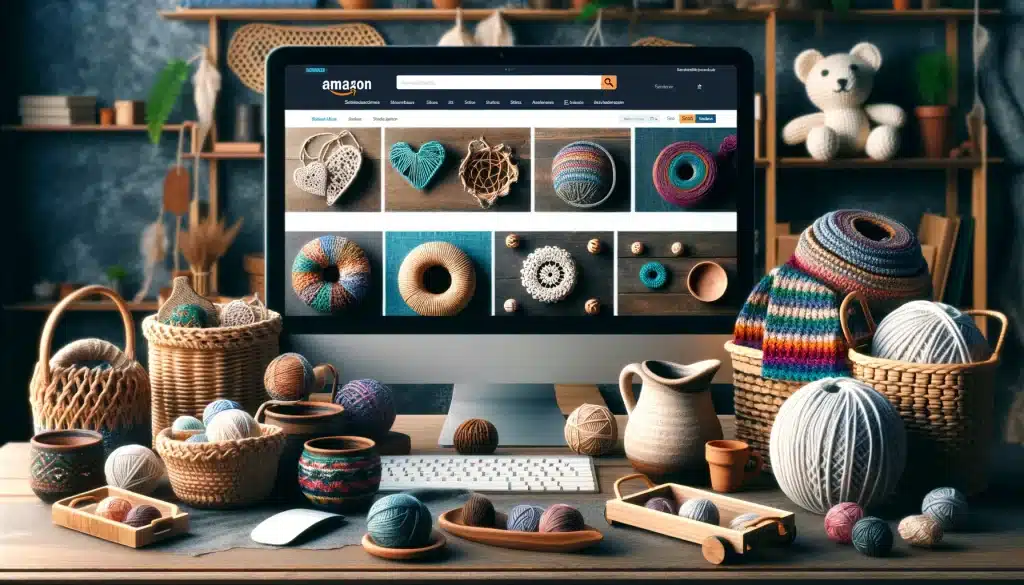If you’re a creative person who loves making handmade items, you might be wondering how to sell your products on Amazon Handmade. Amazon Handmade is a platform that allows artisans to showcase their unique, handmade products to millions of customers worldwide. By selling on Amazon Handmade, you can take advantage of Amazon’s massive customer base and powerful marketing tools to grow your business.
To get started with selling on Amazon Handmade, you’ll need to create an artisan account and apply to join the platform. Once you’re approved, you can start creating your product listings and setting your prices. You’ll also have access to a range of fulfillment options, including Amazon’s Fulfillment by Amazon (FBA) service, which can help you streamline your shipping and handling processes.
In this article, we’ll walk you through the process of selling on Amazon Handmade, from setting up your account to marketing your products and expanding your reach. We’ll cover everything you need to know to get started with selling on Amazon Handmade, so you can start growing your handmade business today.
Key Takeaways
- Create an artisan account and apply to join Amazon Handmade
- Set up your product listings and pricing
- Take advantage of Amazon’s powerful marketing tools to grow your business
What is Amazon Handmade?
If you’re an artisan looking to sell your handmade products, Amazon Handmade is a great platform to consider. Here’s what you need to know about Amazon Handmade to get started.
What Is Amazon Handmade?
Amazon Handmade is a marketplace for artisans to sell their handmade products. The platform offers a wide range of categories for handmade products, from jewelry and clothing to home decor and furniture. By selling on Amazon Handmade, artisans can reach a wider audience and take advantage of Amazon’s vast customer base.
Benefits of Selling on Amazon Handmade
Selling on Amazon Handmade offers several benefits for artisans. First, the platform offers a high level of visibility, as Amazon is one of the most popular online marketplaces in the world. Second, Amazon Handmade provides a secure and reliable platform for transactions, with Amazon handling payment processing and customer service. Third, artisans can take advantage of Amazon’s fulfillment network to store and ship their products, making the process more efficient and cost-effective.
Eligible Product Categories
Amazon Handmade offers a wide range of categories for handmade products. Some of the eligible categories include:

- Jewelry
- Clothing and accessories
- Home and kitchen
- Beauty and personal care
- Toys and games
- Pet supplies
Before you start selling on Amazon Handmade, make sure your products meet the platform’s requirements for handmade products. All products must be made entirely by hand, hand-altered, or hand-assembled (not from a kit). Additionally, all products must fit within one of Amazon Handmade’s eligible categories.
By understanding what Amazon Handmade is, the benefits of selling on the platform, and the eligible product categories, you can start selling your handmade products on one of the world’s largest online marketplaces.
Listen to Seller Session Episode about the real-life story of earning a 7-figure income by selling on Amazon Handmade!
Getting Started on Amazon Handmade
If you’re an artisan and you want to sell your handmade products on Amazon, you’ll need to go through a few steps to get started. In this section, we’ll walk you through the application process and setting up your seller account.
The Application Process
To become a handmade seller on Amazon, you’ll need to apply for approval. The application process is straightforward, but there are a few requirements you’ll need to meet before you can apply.
First, you’ll need to handcraft every product you sell on Amazon Handmade. This means you can’t sell mass-produced items or products that aren’t handmade. Amazon has strict guidelines for what qualifies as a handmade product, so make sure you read through them carefully before you apply.

Once you’ve verified that your products qualify, you can apply to become an artisan seller on Amazon Handmade. You can find the application form here. You’ll need to fill out some basic personal information and provide details about your products. You’ll also need to upload high-quality images that showcase your handmade items.
After you’ve submitted your application, Amazon will review it to make sure you meet all the requirements. If your application is approved, you’ll be able to start selling on Amazon Handmade.
Setting Up Your Seller Account
Before you can start selling on Amazon Handmade, you’ll need to set up a seller account. If you already have a seller account, you can skip this step.
To set up a seller account, go to Amazon Seller Central and create an account. You’ll need to provide some basic information about yourself and your business, such as your name, address, and tax information.
Once you’ve set up your seller account, you can apply to become an artisan seller on Amazon Handmade. If your application is approved, you’ll be able to start listing your handmade products and selling them to customers on Amazon.
Creating Your Handmade Listings

When creating your handmade listings on Amazon, there are a few requirements you need to meet before your products can go live.
Product Listing Requirements
First, you need to ensure that your products meet Amazon’s requirements for handmade goods. These requirements include that the product must be made entirely by hand, hand-altered, or hand-assembled without the use of machines. Additionally, all products must be made by the seller or a member of their team and not mass-produced.
To create a listing, you will need to provide a product title, description, and images. Be sure to accurately describe your product and include any relevant details such as materials used and dimensions.
Optimizing Product Images and Descriptions
When creating your product listings, it’s important to optimize your images and descriptions to attract potential customers. Use high-quality images that showcase your product and highlight its unique features. Make sure to take photos from different angles and include close-up shots of any intricate details.
In your product description, use clear and concise language to describe your product’s features and benefits. Highlight what makes your product unique and why customers should choose your product over others.
When selecting a product category, choose the category that best matches your product. This will help customers find your product more easily when searching for similar items.
By following these guidelines, you can create effective product listings that accurately showcase your handcrafted goods and attract potential customers.
Pricing and Fees
If you want to sell on Amazon Handmade, it’s important to understand the fee structure. There are two types of fees you will need to pay: listing fees and referral fees.
Understanding Amazon’s Fee Structure
Amazon charges a $39.99 monthly subscription fee for a Professional selling account, which is required to sell on Amazon Handmade. This fee is waived for approved applications after the first month. Additionally, there is a referral fee of 15% on the total sales price (including shipping) of each item sold. This fee helps Amazon cover the cost of running the marketplace.
Calculating Profitability
To determine your profitability, you need to calculate your total costs and deduct them from your total revenue. Your costs include the cost of materials, labor, shipping, and Amazon’s fees. You can use Amazon’s Profitability Calculator to estimate your costs and potential profits.
When calculating your costs, keep in mind that Amazon charges a transaction fee of 3% + $0.30 per order, in addition to the referral fee. This fee covers the cost of processing payments and is deducted from your revenue before the referral fee is calculated.
To ensure that your prices are competitive, it’s also a good idea to research your competitors and adjust your prices accordingly. Keep in mind that pricing too high may deter customers, while pricing too low may not cover your costs.
Fulfillment Options
When it comes to fulfilling orders on Amazon Handmade, you have two main options: Fulfillment by Amazon (FBA) and Fulfilled by Merchant (FBM).
Fulfillment by Amazon (FBA)
FBA is a great option for sellers who want to outsource their fulfillment process to Amazon. With FBA, you send your products to Amazon’s fulfillment centers, and they handle the picking, packing, and shipping of your orders. This means that you don’t have to worry about storing inventory, packing orders, or shipping them out yourself.
One of the biggest advantages of FBA is that your products are eligible for Amazon Prime, which can increase your sales and customer satisfaction. Additionally, FBA takes care of customer service and returns, making it a hassle-free option for sellers.
However, FBA does come with fees, including storage fees, fulfillment fees, and referral fees. You can use Amazon’s FBA calculator to estimate your costs and determine whether FBA is the right option for your business.
Fulfilled by Merchant (FBM)
FBM is the option where you, as the seller, handle the entire fulfillment process. This includes storing inventory, packing orders, and shipping them out yourself. FBM is a good option for sellers who want more control over the fulfillment process and want to save on fees.
With FBM, you are responsible for handling customer service and returns, which can be time-consuming. Additionally, your products are not eligible for Amazon Prime, which can impact your sales and customer satisfaction.
However, FBM does give you more control over the fulfillment process, and you can save on fees. You can also use third-party fulfillment services to handle the process for you, which can be a good compromise between FBA and FBM.
Read more related article about Amazon FBA: Amazon Virtual Bundles: Is it right for your FBA Business in 2024?
Marketing Your Products
Once you’ve created your Amazon Handmade seller account and listed your items, the next step is to market your products effectively. Marketing is crucial to get your products in front of potential customers and generate sales. In this section, we’ll discuss two important aspects of marketing on Amazon Handmade: Building Your Brand on Amazon and Leveraging Amazon’s Marketing Tools.
Building Your Brand on Amazon
Building your brand on Amazon Handmade is essential to differentiate yourself from other sellers and establish a loyal customer base. Here are some tips to help you build your brand:
- Create a compelling brand story: Tell your customers why you started your business, what inspires you, and what makes your products unique. This will help you connect with your customers on a personal level and build trust.
- Use high-quality images: Use high-quality images to showcase your products and make them stand out. Customers are more likely to buy products that look professional and attractive.
- Offer excellent customer service: Respond to customer inquiries promptly and resolve any issues quickly. This will help you build a positive reputation and encourage customers to leave positive reviews.
Leveraging Amazon’s Marketing Tools
Amazon offers several marketing tools to help you promote your products and increase sales. Here are some of the most effective tools:
- Amazon Sponsored Products: Sponsored Products is a pay-per-click advertising program that allows you to promote your products on Amazon. You can target specific keywords and products, and you only pay when someone clicks on your ad.
- Amazon Coupons: Coupons are a great way to incentivize customers to buy your products. You can offer discounts on your products and promote them on your product detail pages, search results, and other areas of Amazon.
- Amazon Lightning Deals: Lightning Deals are time-limited promotions that offer deep discounts on your products. These deals are only available for a short period, so they create a sense of urgency and encourage customers to buy quickly.
By leveraging these marketing tools, you can increase your visibility on Amazon and drive more sales.
Managing Your Handmade Business
As an Amazon Handmade seller, managing your business is an essential part of your success. This section covers two critical aspects of managing your handmade business: customer service and community engagement, and analyzing sales metrics and performance.
Customer Service and Community Engagement
Providing excellent customer service is key to building a loyal customer base and growing your handmade shop. Responding promptly to customer inquiries, addressing their concerns, and resolving issues in a timely and professional manner can go a long way in building trust and loyalty.
Engaging with your community is also important in building a strong brand and customer base. Participating in forums, social media groups, and other online communities can help you connect with potential customers, get feedback on your products, and build relationships with other sellers.
Analyzing Sales Metrics and Performance
Analyzing your sales metrics and performance is crucial to understanding how your business is performing and identifying areas for improvement. Amazon Handmade provides a range of tools and reports to help you track your sales, including sales dashboards, order reports, and customer metrics.
Some of the key metrics to track include sales volume, revenue, and profit margins. You can also track customer feedback and ratings to get a sense of how your products are being received and identify areas for improvement.
By regularly analyzing your sales metrics and performance, you can make data-driven decisions to improve your business and achieve greater success on Amazon Handmade.
Expanding Your Reach
Once you have established your presence on Amazon Handmade, it’s time to explore other marketplaces to expand your reach. While Amazon Handmade is a great platform to sell your unique products, there are other marketplaces that can help you reach a wider audience and increase your sales.
Exploring Other Marketplaces
One such marketplace is Etsy, which is a popular platform for handmade and unique products. Etsy has a large customer base and offers a variety of subcategories that can help you target your ideal audience. By listing your products on Etsy, you can reach a new set of customers who are looking for handmade and unique products.
Another option is to sell on Amazon Handmade’s sister platform, Amazon.com. By selling on Amazon.com, you can reach a massive audience and take advantage of Amazon’s fulfillment services. This can help you streamline your operations and focus on growing your business.
Diversifying Your Product Offerings
In addition to exploring other marketplaces, you can also diversify your product offerings to attract new customers. Consider expanding your product line to include complementary items or related products. This can help you appeal to a wider audience and increase your sales.
You can also consider offering custom or personalized products to differentiate yourself from competitors. This can help you stand out in a crowded marketplace and attract customers who are looking for something unique.
Frequently Asked Questions
What are the steps to start selling on Amazon Handmade for beginners?
If you’re a beginner and want to start selling on Amazon Handmade, the first step is to create a seller account on Amazon. Once you have created an account, you can apply to become an artisan on Amazon Handmade. After your application is approved, you can start listing your handmade products for sale.
How does Amazon Handmade’s fee structure work?
Amazon Handmade charges a referral fee on each sale made through the platform. The referral fee varies depending on the category of the product you are selling. Additionally, there is a monthly subscription fee for Professional Selling Plan. For more information on Amazon Handmade’s fee structure, you can visit their FAQ page.
What are the differences between selling on Amazon Handmade and Etsy?
Amazon Handmade and Etsy are both online marketplaces that allow artisans to sell handmade products. However, there are some differences between the two platforms. For example, Amazon Handmade has a larger customer base, while Etsy is more focused on handmade and vintage items. Additionally, Amazon Handmade offers more tools and resources for sellers, such as advertising and analytics tools.
Is a business license required to sell products on Amazon Handmade?
Amazon Handmade does not require sellers to have a business license to sell products on their platform. However, depending on your location and the type of products you are selling, you may need to obtain a business license or permit from your local government.
How can a seller apply to join Amazon Handmade?
To apply to become an artisan on Amazon Handmade, you must first create a seller account on Amazon. Once you have created an account, you can apply to become an artisan by submitting an application and providing information about your handmade products. For more information on how to apply to join Amazon Handmade, you can visit their seller resources page.
What are the potential earnings from selling on Amazon Handmade?
The potential earnings from selling on Amazon Handmade depend on a variety of factors, such as the type of products you are selling, the demand for those products, and your pricing strategy. However, many artisans have found success on Amazon Handmade and have been able to generate a significant amount of income from their sales.


